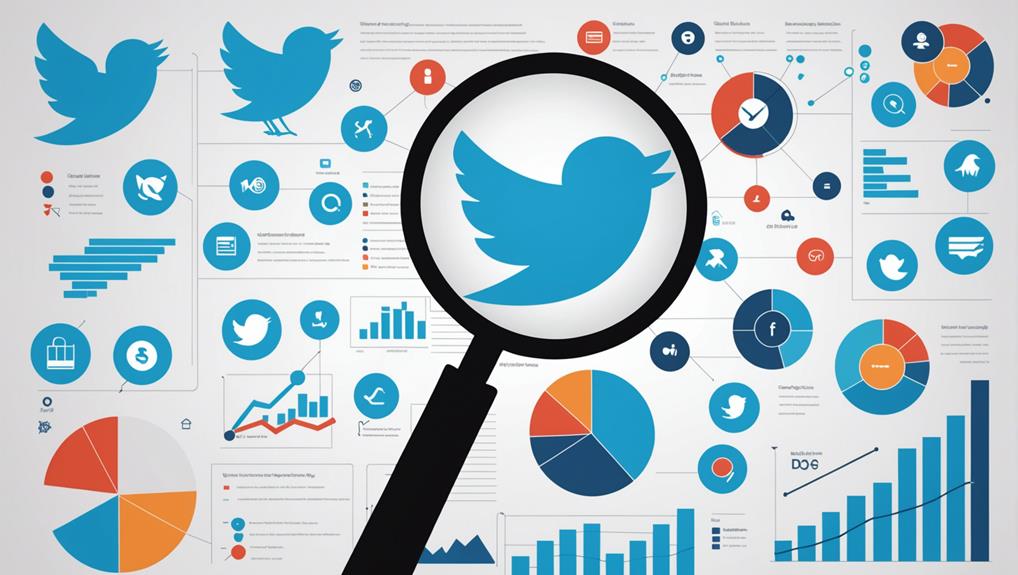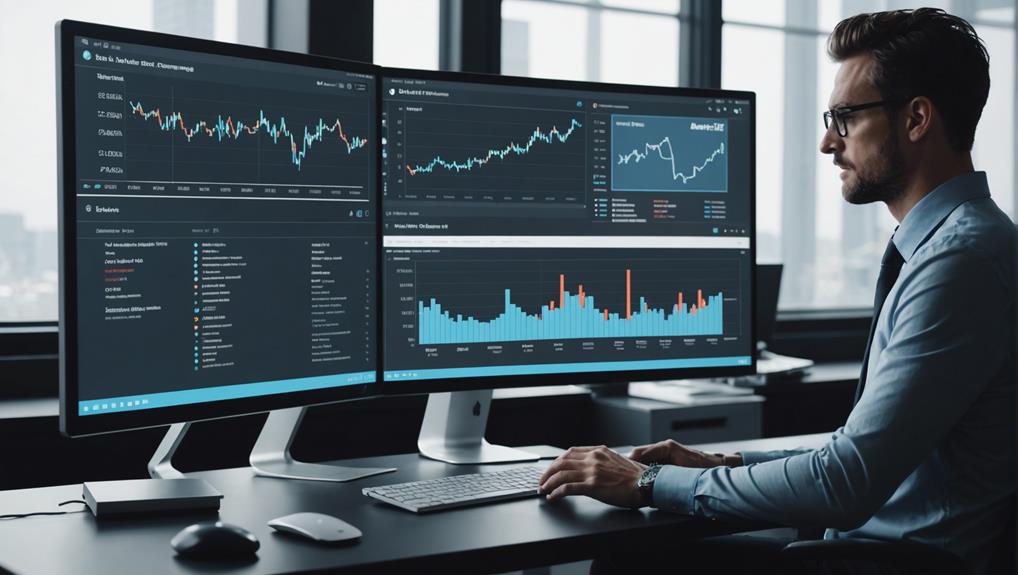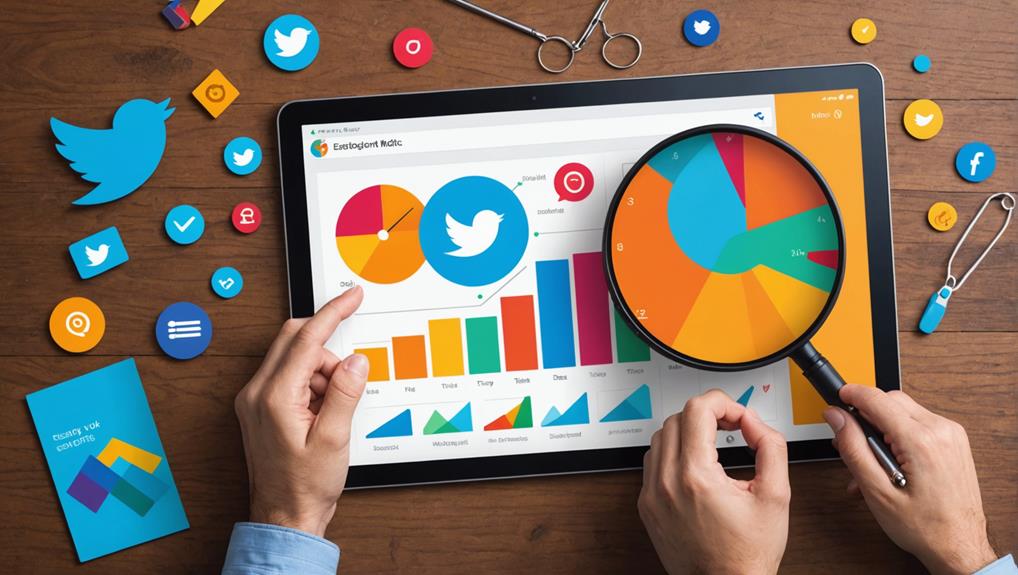Tracking engagement rates is essential for optimizing your social media strategy. Use metrics like likes, comments, shares, and retweets to measure how your audience interacts with your content. An engagement rate formula (interactions divided by followers, multiplied by 100%) helps you see what's working. Tools like Keyhole and Hootsuite offer real-time analytics to provide actionable insights. Consistently monitoring and analyzing these rates allows you to identify trends and refine your approach. High engagement rates indicate strong content resonance, guiding you to create more targeted and impactful campaigns. Continue for strategies to increase your engagement rates effectively.
Key Takeaways
- Engagement rates measure audience interaction through likes, comments, shares, retweets, and saves.
- Calculating engagement rates involves dividing total interactions by total followers, then multiplying by 100%.
- Tools like Keyhole and Hootsuite offer real-time monitoring and detailed analytics of engagement metrics.
- Tracking engagement provides insights for refining content strategy and optimizing audience interaction.
- Higher engagement rates indicate strong content resonance and can highlight influential figures in your niche.
Understanding Engagement Rates
Understanding engagement rates is crucial because they measure how well your content resonates with your audience through likes, comments, shares, and other interactions. When you're focused on measuring effectiveness, engagement rates offer a clear picture of how your audience interacts with your posts. Higher engagement rates typically indicate that your content quality is high and that it resonates well with your target audience.
To measure this interaction accurately, you need to take into account all components of engagement. This includes likes, comments, and shares, but don't forget about other interactions like retweets on Twitter or saves on Instagram. Each platform—whether it's Facebook, LinkedIn, or TikTok—has its own metrics, so it's essential to tailor your analysis accordingly.
Tools like Keyhole are invaluable for making data-driven decisions. They provide insights that help you track and analyze engagement rates effectively. By leveraging these tools, you can strategically optimize your content to enhance audience interaction. This ensures that you're not just guessing but using concrete data to understand what works and what doesn't.
Importance of Tracking Engagement
Monitoring engagement rates is vital because it provides you with actionable insights into how well your content performs and resonates with your audience. When you undertake engagement analysis, you're fundamentally measuring the effectiveness of your social media strategy. This data-driven approach allows you to identify trends, preferences, and areas for optimization.
By tracking engagement rates, you gain a better understanding of audience interaction, which is invaluable for targeted content creation. You'll see what types of posts generate the most likes, shares, and comments, giving you a clear picture of what your audience finds engaging. This enables you to refine your content strategy to better meet their needs and preferences.
Furthermore, tracking engagement rates allows you to compare performance over time. By setting benchmarks, you can measure success and make informed decisions for future campaigns. This strategic approach ensures you're not just creating content blindly but are guided by concrete data.
Calculating Engagement Rates
To effectively measure how well your content resonates with your audience, you need to calculate engagement rates using a straightforward formula: total interactions divided by total followers, multiplied by 100%. This metric is essential for measuring effectiveness and understanding your content's true impact.
Total interactions encompass likes, shares, comments, and other engagements your posts receive. By dividing these interactions by your total followers and then multiplying by 100%, you get a clear percentage that reflects how engaged your audience is. This engagement rate helps you benchmark competitors and gauge your performance against industry standards.
Analyzing trends over time is another strategic advantage of calculating engagement rates. By monitoring these rates consistently, you can identify patterns that reveal which types of content resonate most with your audience. This data-driven approach allows you to fine-tune your strategy for improved results.
Moreover, identifying influencers in your niche becomes easier. Higher engagement rates often signal influential figures whose content commands attention.
Tools like Keyhole offer real-time calculations and insights to optimize your engagement rates, making it easier to measure effectiveness and stay ahead of the competition. Use these insights to refine your content strategy and achieve better audience engagement.
Improving Twitter Engagement
Boosting your Twitter engagement requires strategic actions that resonate with your audience and spur interactions. To improve your engagement rates, focus on engagement strategies that foster active follower interaction.
Here are three key steps to enhance your Twitter presence:
- Create Relevant and Timely Content: Consistently share content that aligns with your audience's interests and current trends. Analyzing your engagement rate helps you understand which topics and types of content perform best. Aim to post during peak times when your followers are most active to maximize visibility.
- Engage Directly with Followers: Interaction is important for improving engagement. Respond to replies, retweet user-generated content, and acknowledge mentions. This direct engagement makes your followers feel valued and encourages more interactions. Remember, every like, retweet, reply, and mention contributes to your overall engagement rate.
- Utilize Multimedia: Tweets with images, videos, and GIFs generally receive higher engagement. Data shows that multimedia content can notably increase likes and retweets. Experiment with different formats to see what resonates most with your audience.
Tools for Tracking Engagement
Utilizing the right tools for tracking engagement allows you to understand the effectiveness of your Twitter strategies in real-time. Tools like Keyhole and Hootsuite are essential for monitoring engagement metrics such as likes, shares, and comments. By offering detailed analytics, these platforms provide a thorough view of how your content is performing and how your audience is interacting with it.
Tracking engagement trends over time is vital for evaluating both short-term and long-term success. These tools enable you to identify which types of content resonate most with your followers, allowing you to fine-tune your strategy for maximum impact.
Additionally, automation features in tools like Hootsuite save you significant time on manual reporting and benchmarking, freeing you up to focus on strategy rather than data collection.
Moreover, these platforms offer invaluable social media insights that help you understand your social media ROI. By making data-driven decisions, you can optimize your content to better meet your audience's preferences and needs. Utilizing these tools not only enhances your ability to track engagement but also empowers you to make strategic adjustments that will drive better results over time.
Frequently Asked Questions
What Is KPI for Engagement Rate?
The KPI for engagement rate is an essential engagement metric. It measures audience interaction by calculating total engagements divided by total followers, then multiplied by 100. High engagement rates indicate your content resonates well with your target audience.
Why Is It Important to Measure Engagement Rate?
Measuring engagement rate is essential because it gives you direct customer feedback and allows you to refine your content strategy. High engagement rates indicate content effectiveness, helping you optimize for better audience connection and overall social media growth.
What Should Be the Ideal Engagement Rate?
Your ideal engagement rate should align with industry standards, typically between 1-5%. Benchmark comparisons will help you understand your performance. Focus on meaningful interactions to gauge true audience resonance and drive strategic improvements.
What Is a Good Engagement Rate Analytics?
A good engagement rate in analytics typically ranges from 1% to 5%. To achieve this, focus on metrics analysis and audience interaction. Benchmarking and continuous optimization are key to enhancing your social media strategy.
Conclusion
By understanding and tracking engagement rates, you can strategically improve your Twitter presence. Calculating these rates provides clear insights into what content resonates with your audience.
Use tools like Hootsuite or Sprout Social to streamline this process and guarantee you're making data-driven decisions. Remember, boosting engagement isn't just about numbers—it's about fostering genuine connections with your followers.
Stay focused on these strategies, and you'll see measurable improvements in your social media impact.




